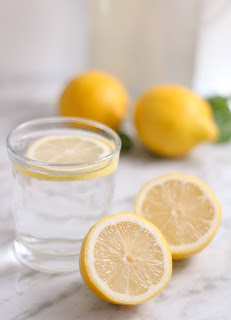How clever food marketing makes you think you're being healthy
Food labelling laws are generally quite strict and well-regulated but that doesn’t stop the marketing departments of food companies trying to sell you food products with misleading labels. They know people are becoming increasingly conscious of what they eat so they’ve developed labels that have no real meaning but have a vague promise of healthiness.
The food marketing terms I’m going to talk about are:
‘Superfood’
‘Natural’
‘Detox’
‘High protein’
These particular terms have really taken off and I see on so
many products now. Keep reading to find out what the terms really mean and if
they are all they’re cracked up to be.
‘SUPERFOOD’
First, let’s start with superfood, this word has blown up
recently and everyone is talking about superfoods and how you should be eating
them all the time. In reality, superfood has no legal definition and it’s
typically used to describe foods that are nutrient rich. Some examples of foods
commonly labelled as ‘super’ include: blueberries, spinach, and quinoa. They’re also used to describe powders like maca, spirulina, and acai. I’ve done
a previous post about how we don’t need extra green powders and pills and I’ll
link it here.
The foods labelled as ‘super’ are sold as something extra
special, as if they have magical health properties when really, they don’t. We
already know that fruit, vegetables, and wholegrains are a great source of
nutrients and that they should be a key part of our diet. There is no need for
this extra label. Buying ‘superfoods’ doesn’t mean that what you're buying is
superior to other foods. If you want to eat more healthily it can be easier to
try and incorporate more veg into your meals or to swap to wholegrain carbohydrate
options. Making a few simple swaps can be more beneficial than
forking out for a supposed ‘superfood’ product.
To summarise, there is no such thing as a superfood, and we
shouldn’t be putting certain foods on a pedestal.
‘NATURAL’
Another word I see on so many products is ‘natural’, and most people assume that if something is natural then it must be healthy and must be good for you. Natural on a food label means that the product is made from natural ingredients, i.e., ingredients produced by nature and not manmade.
There are plenty of natural things that you wouldn’t want to eat. For example,
raw and undercooked kidney beans contain a toxin called phytohaemagglutinin that
can cause severe vomiting and diarrhoea. This is ‘natural’ but you wouldn’t
want to consume it. And don’t worry, the toxin is destroyed if the beans are
soaked overnight and cooked at a high temperature.
Also, there are some food flavourings and colourings that are natural, but you might not find them very appetising. Carmine red, also known as cochineal, is a natural red food colouring made from crushed up cochineal insects. Its E (additive) number is E120, and it’s used in lots of products ranging from M&Ms to strawberry yoghurt. This is a natural flavouring but when you think of the word natural you might not have imagined crushed insects in your yoghurts.
Nature Valley are another brand that play on the word natural. A serving of the Nature Valley Crunchy Oats & Honey Cereal Bar has 11.3g of sugar, this is a third of your recommended intake for added sugars. Excess sugar intake can lead to weight gain and dental decay. Although they use natural ingredients like wholegrain oats, it’s still a big contribution to your added sugar intake.
While a lot of things with the word natural are good for you and safe to eat, don’t assume that everything that’s natural is automatically healthy.
‘DETOX’
If you follow me on Instagram (@kaegoskitchen) you’ll know
how much I dislike this word. There are so many products, not just food, that
are labelled as detox products. Detoxification means to rid the body of toxins
or unhealthy substances. These products never say what toxins they're getting
rid of or how they’ll get rid of them. This is because, and I hate to say it,
nothing you eat can detox you. If you think about it, it doesn’t even make
sense. Anything you eat or drink gets digested and broken down into smaller
nutrients, these then gets transported around the body to where it’s needed.
How will a detox food or drink be able to go through the digestion process and
then be able to rid your body of toxins?
An internet search of ‘detox foods’ brings up lots of
options that can apparently cleanse the body and flush out toxins. This
includes foods such as leafy green veg, and lemon water. These detox foods are
just normal foods, they don’t have special powers. Your liver and kidneys are
constantly working to get rid of any harmful substances in the body and they
don’t get enough credit. You don’t need anything extra to detox you, if
either your liver or kidneys needed extra help to do their jobs then you would
require hospital treatment as it’s very serious.
As I said, a lot of the foods labelled as ‘detox foods’ are
just vegetables, fruits and nuts. These foods are high in nutrients so can
support your liver and kidney health, as well as your general body health, but
it doesn’t mean that the food itself will detox you.
‘HIGH PROTEIN’
The final marketing claim is high protein and there is a
legal definition for this claim, but it can be misleading. My issue with this
claim is that there are loads of foods naturally high in protein that aren’t
labelled as such. It can be misleading and make people think that some products
are superior to others based on protein content when this may not be the case.
For a food to have the label ‘high protein’ at least 20% of the energy
value of the food must come from protein. All the energy (calories) from food
comes from the 3 macronutrients: carbohydrates, protein, and fat. This means to
meet the high protein label, for example, if a food has 100 calories, at least
20 of those calories have to come from protein. Protein has 4 calories per gram
so if a product has 5g of protein, this will be 20 calories. Information about
the composition of foods will be at the nutrition label on the back of the
product.
I’m going to give some examples of foods that are labelled
high protein compared to other foods that are also high in protein but aren’t
labelled as such. This will show how seeing the label ‘high protein’ doesn’t
always mean that that food is better than another.
- Arla Protein strawberry yoghurt has 10g protein per 100g VS Fage 5% classic Greek yoghurt which has 9g protein per 100g.
- Fuel’s Chocolate Protein boosted granola has 15.6g protein per 100g VS Tesco’s grains and seeds granola which has 12.9g per100g.
- Graze’s punchy nut punchy Protein bag has 22g protein per 100g VS Tesco’s Mixed Nuts which has 20.4g per 100g.
Evidently, there is plenty of protein in other foods and you
don’t have to look for foods that are specifically labelled high protein. The
‘high protein’ foods are usually more expensive too, so this will save some
money by going for the regular products.
As you can see, most of these marketing terms don’t have a
lot of meaning and they don’t necessarily help you determine whether a food
product is healthier than another. I’d advise you to buy products that you
like/enjoy and not to buy products based on the marketing labels. If you want
more information about a product, you can look at the nutrition label on the
back.
I hope you enjoyed this blog post.
Bye for now! 👋
References:
Food labelling law: High protein nutrition claim https://ec.europa.eu/food/food/labelling-and-nutrition/nutrition-and-health-claims/nutrition-claims_en
Food labelling regulations, Food Standards Agency 2002:
CRITERIA FOR THE USE OF THE TERMS FRESH, PURE, NATURAL ETC IN FOOD LABELLING https://www.5aldia.org/datos/60/PDF_4_5106.pdf
Carmine red: https://www.ncbi.nlm.nih.gov/pmc/articles/PMC6110711/
Kidney beans: https://pubmed.ncbi.nlm.nih.gov/26479307/
Added sugar recommendations:
https://www.nhs.uk/live-well/eat-well/how-does-sugar-in-our-diet-affect-our-health/
Role of kidneys: https://www.ncbi.nlm.nih.gov/pmc/articles/PMC6115656/
and https://pubmed.ncbi.nlm.nih.gov/15772298/
Role of liver: https://pubmed.ncbi.nlm.nih.gov/1289084/
Nutritional information from Tesco.com


.jpg)

Comments
Post a Comment